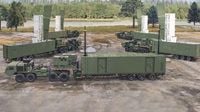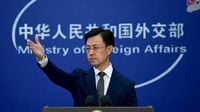On August 29, 2025, tensions in East Asia ratcheted up another notch as Russia and China issued stern warnings to Japan over its decision to allow the United States to temporarily deploy its Typhon intermediate-range missile system during upcoming joint military exercises. The move, which Japanese and U.S. officials confirmed would take place at the U.S. Marine Air Station in Iwakuni, Honshu, from September 11 to 25 as part of the "Resolute Dragon" drills, has sparked a flurry of diplomatic protests and reignited concerns about the region’s fragile security balance.
The Typhon missile system, a relatively new addition to the U.S. arsenal, has already drawn controversy in Asia. According to Reuters, the system was first deployed in the Philippines during a training exercise in 2024, prompting an immediate rebuke from Beijing. Now, its presence in Japan for the first time is being interpreted by many as a signal to both China and Russia, especially in the context of recent Russian military drills in the Sea of Japan.
Russia’s Ministry of Foreign Affairs was quick to voice its disapproval. Spokeswoman Maria Zakharova, speaking to the state-run TASS news agency, described the deployment as "another destabilizing step as part of Washington’s course toward ramping up the potential of ground-based shorter and intermediate-range missiles." She went on to state, "Deploying Typhon missiles in regions near Russia poses a direct strategic threat to Russia." Zakharova warned that if Japan does not reconsider its decision, Moscow "will have to take appropriate military-technical measures," and added pointedly, "We will assume that the entire responsibility for the further degradation of the situation in the region rests on the Japanese side."
China, for its part, echoed Russia’s concerns while striking a distinctly historical note. Chinese Ministry of Foreign Affairs spokesperson Guo Jiakun, as quoted by the state-run Xinhua news agency, said, "China always opposes the United States deploying the Typhon Mid-Range Capability missile system in Asian countries." Guo urged Japan to "take a hard look at its history of aggression, follow the path of peaceful development, act prudently in military and security areas, and refrain from further losing the trust of its Asian neighbours and the international community." He further called on Washington to "draw lessons from history and devote more effort and resources to doing the right thing rather than the other way around."
The Typhon system is at the heart of Washington’s drive to amass a range of anti-ship and advanced weapons in Asia. According to Japanese media reports, including Kyodo News, the upcoming exercise will be the first time the U.S.-made Typhon missile system is deployed in Japan, and its scheduled withdrawal at the end of the drills is meant to underscore the temporary nature of the move. Still, the symbolism is hard to miss. Analysts cited by South China Morning Post suggest the deployment is a clear strategic signal to Beijing, especially with the notional enemy in the Resolute Dragon exercise reportedly being China itself—a detail that has not gone unnoticed in the region.
The Typhon system is capable of firing Tomahawk cruise missiles, which can hit targets in both China and Russia from as far away as the Philippines, as well as SM-6 missiles designed to strike air or sea targets over 200 kilometers away. While it remains unclear whether the Typhon missiles will actually be fired during the Resolute Dragon 25 exercises, officials from Japan’s Ground Self-Defense Force told Reuters that the primary aim is to "enhance deterrence, response capacity and integrated operations" between the U.S. and Japanese forces.
For Japan, the decision to host the Typhon system—even temporarily—marks another step in what Moscow has described as "accelerated militarisation" and deepening security cooperation with the United States. This trajectory is not without controversy within Japan itself, where debates over the country’s pacifist constitution and its evolving defense posture have become increasingly fraught as regional threats have grown. While some in Japan see closer military ties with the U.S. as a necessary deterrent against an assertive China and an unpredictable North Korea, others worry about being drawn into a new arms race or, worse, a regional conflict.
China’s reaction, as reported by Xinhua, has been particularly sharp. The foreign ministry warned that "the deployment of the system in Japan will further undermine the legitimate security interests of other countries" and urged both the U.S. and Japan not to introduce the Typhon missile system to the region. The statement reflects Beijing’s longstanding position that U.S. military deployments in Asia are destabilizing and threaten China’s own security interests, especially when it comes to sensitive flashpoints like Taiwan and the East China Sea.
Meanwhile, Russia’s warnings have taken on a distinctly military tone. By threatening "military-technical measures" in response to the Typhon deployment, Moscow is signaling that it views the move as more than just a symbolic gesture. The Russian government has also expressed concern about what it sees as Japan’s increasing willingness to support U.S. military initiatives, a shift that could have far-reaching implications for the security architecture of Northeast Asia.
The United States, for its part, has framed the deployment as part of a broader effort to strengthen deterrence and ensure stability in the region. U.S. officials have pointed to recent Russian military drills in the Sea of Japan as one reason for the decision to bring the Typhon system to the Resolute Dragon exercise. The timing is hardly coincidental, and it highlights the ongoing cycle of action and reaction that has come to define great power competition in East Asia.
It’s worth noting that the Typhon system’s previous deployment in the Philippines during a 2024 training exercise also drew strong criticism from China. Manila has since announced plans to acquire the land-based missile system, which has a range of about 480 kilometers (roughly 300 miles), with a longer-range version reportedly in development. The growing interest in the Typhon system among U.S. allies in the region underscores the shifting strategic landscape and the increasing importance of missile capabilities in the Asia-Pacific.
As the Resolute Dragon 25 exercise approaches, all eyes will be on Iwakuni and the broader implications of the Typhon deployment. Will this latest move serve as a deterrent, as U.S. and Japanese officials hope, or will it further inflame regional tensions and prompt new rounds of military posturing? With Russia and China both vowing to respond and urging Japan to reconsider, the coming weeks are likely to test the delicate balance of power in East Asia.
The Typhon deployment may be temporary, but the questions it raises about security, sovereignty, and the future of the region are anything but fleeting.


